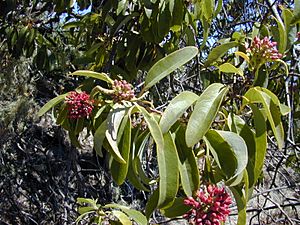Forest sandalwood facts for kids
Quick facts for kids Forest sandalwood |
|
|---|---|
 |
|
| S. freycinetianum var. lanaiense | |
| Conservation status | |
| Scientific classification | |
| Genus: |
Santalum
|
| Species: |
freycinetianum
|
| Varieties | |
|
S. f. var. freycinetianum |
|
Santalum freycinetianum, also known as the forest sandalwood or ʻIliahi, is a special type of flowering tree. It belongs to the European mistletoe family, which might sound surprising! This tree is found only in the Hawaiian Islands, meaning it's endemic there.
Its scientific name, freycinetianum, honors a French explorer named Henri Louis Claude de Saulces de Freycinet. The ʻIliahi tree grows in different kinds of forests across Oʻahu, Kauaʻi, Lānaʻi, Maui, and Molokaʻi. You can find it at elevations from about 250 to 950 meters (820 to 3,117 feet) above sea level. It likes areas that get a good amount of rain, from 500 to 3,800 mm (20 to 150 inches) each year.
Like some other plants in its family, ʻIliahi is a root hemi-parasite. This means it gets some of its food and water from the roots of other plants, called "host plants." Some common host plants for ʻIliahi include koa (Acacia koa), koaiʻa (Acacia koaia), and ʻaʻaliʻi (Dodonaea viscosa).
Types of ʻIliahi Trees
The ʻIliahi tree has a few different types, called varieties. These varieties are found on different Hawaiian islands.
- Santalum freycinetianum var. freycinetianum is found on Molokaʻi and Oʻahu.
- Santalum freycinetianum var. lanaiense is also known as Lānaʻi Sandalwood. You can find it on Lānaʻi and Maui.
- Santalum freycinetianum var. pyrularium is called Kauaʻi Sandalwood. It grows on Kauaʻi.
Uses of ʻIliahi
ʻIliahi trees have been used by people for a long time. Their wood and other parts have special qualities.
Non-Medicinal Uses
The ʻlaʻau ʻala, or heartwood, of the ʻIliahi tree has valuable, sweet-smelling essential oils.
- Historical Trade: Between 1791 and 1840, these trees were cut down and sent to China. The hard, yellowish-brown wood was used to make carved objects, chests, and incense. The trade of ʻIliahi was busiest from 1815 to 1826.
- Native Hawaiian Crafts: Native Hawaiian people used the wood to build pola. This was the deck found on a waʻa kaulua, which is a double-hulled canoe.
- Perfume and Cloth: Powdered ʻlaʻau ʻala was used as a perfume. It was also added to kapa cloth to make it smell nice.
Traditional Medicinal Uses
Native Hawaiian people used parts of the ʻIliahi tree for traditional health practices.
- Hair Treatment: They would mix leaves and bark from the ʻIliahi with ashes from naio (Myoporum sandwicense). This mixture was used to help with kepia o ke poʻo (dandruff) and liha o ka lauoho (head lice).
- Other Remedies: ʻIliahi shavings were sometimes mixed with other plants. These included ʻawa (Piper methysticum), nioi (Eugenia reinwardtiana), ʻahakea (Bobea spp.), and kauila (Alphitonia ponderosa). This combination was used to treat certain illnesses.


